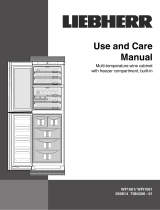
Contents
1 The appliance at a glance............................. 2
1.1 Additional benefits............................................ 2
1.2 Overview of the appliance and its equipment... 3
1.3 Range of appliance use.................................... 3
1.4 Conformity........................................................ 3
1.5 Installation dimensions .................................... 4
1.6 Energy saving................................................... 4
1.7 Example of food arrangement.......................... 4
2 General safety information........................... 4
3 Controls and displays................................... 5
3.1 Operating and control elements....................... 5
3.2 Temperature display......................................... 6
4 Start-up........................................................... 6
4.1 Transporting the appliance............................... 6
4.2 Setting up the appliance................................... 6
4.3 Changing the door hinges................................ 7
4.4 Side-by-side installation................................... 11
4.5 Water connection............................................. 14
4.6 Installation into a fitted kitchen......................... 15
4.7 Anti-tip device................................................... 15
4.8 Installing the water filter.................................... 15
4.9 Disposal of packaging...................................... 17
4.10 Connecting the appliance................................. 17
4.11 Switching on the appliance............................... 18
5 Operation........................................................ 18
5.1 Temperature display unit.................................. 18
5.2 Brightness of the temperature display.............. 18
5.3 Child-proof lock................................................ 19
5.4 Door alarm....................................................... 19
5.5 Temperature alarm........................................... 19
5.6 Sabbath Mode.................................................. 19
5.7 Fridge compartment......................................... 20
5.8 Freezer compartment....................................... 22
6 Maintenance................................................... 24
6.1 Replacing the water filter.................................. 24
6.2 Defrosting with NoFrost.................................... 25
6.3 Cleaning the appliance..................................... 25
6.4 Cleaning the IceMaker..................................... 26
6.5 Customer service............................................. 26
6.6 Appliance Information...................................... 26
7 Troubleshooting............................................. 27
8 Putting appliance out of service.................. 30
8.1 Vacation Tips.................................................... 30
8.2 Switching off the appliance............................... 30
8.3 Decommissioning ............................................ 30
9 Disposing of the appliance........................... 30
10 Liebherr Warranty Plan................................. 31
Congratulations on the purchase of your new appliance.
With this purchase, you have chosen all the advantages of
the latest refrigeration technology, guaranteeing you a
high-quality appliance with a long life span and high oper-
ating safety.
The equipment of your appliance gives you the highest
level of day-to-day ease of operation.
Together we are making an active contribution to the
conservation of our environment by purchasing this appli-
ance which is manufactured in an environmentally friendly
process with the use of recyclable materials.
We hope you enjoy your new appliance.
The manufacturer is constantly working to improve all
models. Therefore please understand that we reserve the
right to make design, equipment and technical modifica-
tions.
To get to know all the benefits of your new appliance,
please read the information contained in these instruc-
tions carefully.
The instructions apply to several models, so there may be
differences. Sections which only apply to certain appli-
ances are indicated with an asterisk (*).
Instructions for action are marked with a , the
results of action are marked with a .
1 The appliance at a glance
1.1 Additional benefits
- CFC free
- Energy-optimized refrigerant circuit
- Energy-efficient insulation
- Low energy consumption
- User-friendly electronic controls
- Active function indicators
- Temperature can be controlled in the appliance inde-
pendent of ambient conditions according to its climate
rating - Temperature can be displayed as °C or °F
- The appliance defrosts automatically - no need to
spend time defrosting
- Large refrigeration capacity
- Safety glass storage shelves
- Adjustable door shelves for tall bottles
- Large freezing capacity
- Shelves can be removed to make space for large items.
- Freezer over-temperature alarm
- Quick-freeze feature for fresh food (SuperFrost)
- Frozen food temperature indicator
- Power failure/“frost-control” display
- All freezer drawers suitable for quick-freeze
- Bright LED interior light
- Door ajar alarm
- Handle grips on all extra-large drawers for easy trans-
port
- Integrated transport grips on appliance housing
- Transport castors at back
- Easy to clean
- Door hinges can be reversed
The appliance at a glance
2 * Depending on model and options




















